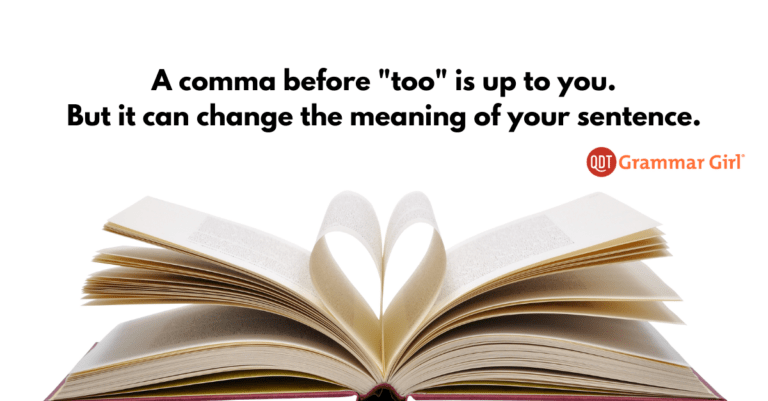Today guest-writer Bonnie Trenga is going to tell us how one little comma can change the meaning of a sentence.
Should we write, “He has the ball too” with no comma or “He has the ball, too”? Well, you can write the sentence either way. It’s up to you as the writer. A comma before the “too” gives the sentence just a slightly different meaning than the sentence without one.
The Difference a Comma Makes
The word “too” is an adverb that indicates “also” or “in addition.” It most often shows up in the middle or at the end of a sentence. Most of the time you probably won’t use a comma with “too” because your sentences will be chugging along without needing a pause. So you could say, “I too like reading mysteries” or “I like reading mysteries too.” If, on the other hand, you want to emphasize an abrupt change of thought (1), you do use commas, which, among other things, are used to indicate pauses: “I, too, like reading mysteries” or “I like reading mysteries, too.” In these sentences, you are adding a pause to create emphasis.
There is no right or wrong here. Comma or no comma after “too” is really up to you and the context of the paragraph where the “too” sentence is. If you want to emphasize your thought, you can add the comma to slow the sentence down. If no emphasis is necessary, then no comma is necessary.
Other Words and Commas
You might be faced with this comma conundrum when using other short transitional adverbs, such as “therefore” and “however.” You could say something like, “He likes mustard. I however prefer ketchup.” Here, you’re just stating a regular thought with no particular emphasis, so no commas. If you really want to contrast your preference and would like to indicate a clear break in thought, then it would be fine to use commas: “He likes mustard. I, however, prefer ketchup.”
Starting a Sentence with “Too” and Other Transitional Adverbs
When you use words like “also,” “in addition,” “however,” and “therefore” in the middle of a sentence, you as the writer get to decide if you want to set them off with commas. If you feel a pause is warranted, go ahead and use commas. When you start a sentence with one of these words, on the other hand, you need to use a comma right after the transitional adverb (2) because you’re definitely changing course.
Let’s look at the word “however,” which is often synonymous with “nevertheless.” If you were discussing the likes and dislikes of Squiggly and Aardvark, you might say, “Squiggly doesn’t care which Popsicle he gets. However, Aardvark really wants a cherry one.” Here, you’re making the contrast a big deal, so a comma is warranted. Note that sometimes “however” means “to whatever extent,” as in “However loud you can yell, I can yell louder.” In that case, you don’t use a comma.
So we’ve seen that you can start a sentence with “also,” “in addition,” “however,” and “therefore.” The word “too,” though, is a little different. It’s poor style, according to some (1, 3, 4), to start a sentence with “too” and a comma. It does sound odd to say something like, “Too, I like ketchup.” Too, I think that’s weird and I would counsel against saying or writing a sentence like that. It would be better to start the sentence with “moreover” or “furthermore” (4) plus a comma: “Moreover, I like ketchup.”
Summary
In summary, there are many times when you have to use a comma, for example when you are listing items in a series. But you get to choose whether you want a comma with your “too.”
Administrative
The Curious Case of the Misplaced Modifier
This podcast was written by Bonnie Trenga, author of The Curious Case of the Misplaced Modifier, who blogs at sentencesleuth.blogspot.com, and I’m Mignon Fogarty, the author of the paperback book Grammar Girl’s Quick and Dirty Tips for Better Writing.
References
- 1. “Commas, ” Chicago Manual of Style FAQ, (accessed Oct. 16, 2008).
- 2. Lutz, G. and Stevenson, D. Grammar Desk Reference. Cincinnati: Writer’s Digest Books, 2005, pp. 203-4.
- 3. The Chicago Manual of Style. Fourteenth Edition. Chicago: University of Chicago Press, 1993, p. 169.
- 4. Garner, B. Garner’s Modern English Usage. Oxford: Oxford University Press. 2003, p. 793.
Image courtesy of Shutterstock.




